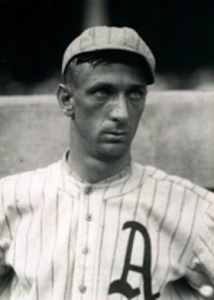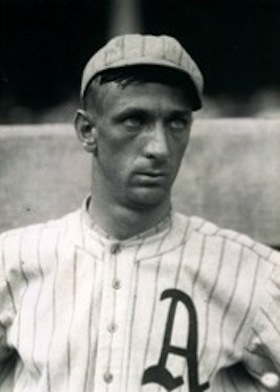September 28, 1916: Jack Nabors finishes season with a 1-20 record
 The 1916 Philadelphia Athletics were the worst major-league team of the twentieth century. And the unfortunate man who bore the brunt of their badness was pitcher Herman John “Jack” Nabors.
The 1916 Philadelphia Athletics were the worst major-league team of the twentieth century. And the unfortunate man who bore the brunt of their badness was pitcher Herman John “Jack” Nabors.
Just two years earlier, the A’s had won 99 games for the best record in baseball. But facing financial pressure from the Federal League, owner-manager Connie Mack either sold his star players or let them go to the Feds rather than meet their salary demands. Hall of Famers Eddie Collins, Eddie Plank, Chief Bender, and Frank “Home Run” Baker were all elsewhere when the 1915 season began; Jack Barry, Eddie Murphy, Bob Shawkey, and Herb Pennock were sold or waived in midseason. The gutted A’s finished 1915 with a record of 43-109, 56 games worse than the year before
It got worse in 1916.
After splitting a doubleheader with the Yankees on May 30, 1916, the A’s had a record of 14-22 and weren’t even in last place. (They were a half-game ahead of the St. Louis Browns.) But the Yankees swept a twin bill from the A’s the next day, starting a remarkable stretch that saw the A’s go 5-58 through August 8. On September 27 they lost their 114th game of the season, breaking the twentieth-century record for losses set by the 1904 Senators.
The next day Jack Nabors took the mound.
Nabors had made a remarkable rise to the major leagues the year before, when Mack purchased him from the Newnan (Georgia) Cowetas of the Class D Georgia-Alabama League. Nabors had gained national attention on June 15, 1915, when he pitched a 13-inning no-hitter against Talladega (Alabama). He didn’t walk anyone, either; two men reached on errors, preventing him from a perfect game.1 He also pitched a 15-inning shutout against Anniston (Alabama) in which he allowed only three hits.2
Nabors had a 12-1 record when Mack purchased him in July after what Sporting Life termed “a spirited bidding contest.”3 Of course, Mack may not have had perfect information about his new acquisition. An item in Sporting Life in July 1915 claimed Nabors was “but 20 years of age,” but he was actually dominating Class D competition at the age of 27.4
It didn’t go well for Nabors when he reached Philadelphia. He allowed eight runs in his first start and nine in his second, and he finished the season with an 0-5 mark. But with the A’s, as noted, rather short on talent, Nabors was still with the team in 1916, and he was the Opening Day starter against the defending World Series champion Red Sox, pitching four shutout innings before being relieved. He finally broke through with a victory in his third start of the season, on April 22, pitching a complete game in a 6-2 win over Boston; both runs against him were unearned. (Fielding was an issue for the 1916 A’s. They committed 314 errors in 154 games, leading to 191 unearned runs, nearly one-fourth of all the runs they allowed.)
But after that, given little support by his teammates (in addition to their defensive woes, the A’s averaged less than three runs a game), Nabors saw the losses pile up, despite some fine performances along the way. He lost two games in which he did not allow an earned run, and three others in which he allowed only one. On June 24 he took a one-hitter into the ninth inning against the Red Sox, only to lose. He took a 1-19 record to the mound against the Washington Senators on September 28.
The A’s took a 1-0 lead in the third inning when Thomas Healy singled, went to second on a bunt by Lee King, and scored from second on a wild pitch by Bert Gallia.5 Meanwhile, Nabors held the Senators scoreless on four hits through five innings.6 But Washington tied the game when Nabors’ defense let him down in the sixth. Joe Leonard singled with one out, and after Eddie Foster flied out, Mike Menosky hit a groundball to Roy Grover at second base for what should have been the third out. But Grover fumbled it, and his throw to second to try to retire Leonard was too late. Elmer Smith followed with a single to score Leonard.7
Washington broke the tie in the seventh inning. Howie Shanks and Ray Morgan opened the inning with singles, moved up a base on a sacrifice bunt by John Henry and scored on a sacrifice fly by Gallia.8 (Morgan’s hit, a line drive through the legs of third baseman Healy, who was playing in anticipating a bunt, led to some comedy from Senators third-base coach and noted baseball clown Nick Altrock. “After that Nick did some fancy ducking and imitating of Healey [sic] until the inning closed,” according to the Washington Evening Star.9) Nabors held the Senators scoreless in the eighth inning before being removed for a pinch-hitter; reliever Rube Bressler allowed two runs in the ninth to make the final score 4-1, Washington.
The loss was Nabors’ 20th of the season (something not noted in the newspaper accounts of the game) and his 19th straight, still the major-league record for most consecutive losses in a season. This despite the fact that he allowed only two runs in eight innings. “It was one of Nabors’ best exhibitions,” according to the Philadelphia Inquirer, “for he forgot to pass a man [in other words, he didn’t walk anyone], eliminated wild pitches from his repertoire and in general behaved with all the skill and cunning a regular mounds-man uses in his daily labors.”10
This would be Nabors’ final start of the season, although he pitched twice more in relief, including in the final game of the season, in which he worked the final four innings to earn a save by modern standards as the A’s knocked off the pennant-winning Red Sox and their 23-game winner Babe Ruth. With a final record of 1-20, Nabors still holds the major-league record for most losses in a season by a pitcher with no more than one win. (His 1916 teammate Tom Sheehan ranks second in that category with a 1-16 mark, a record equaled by Mike Parrott of the Mariners in 1980 and Anthony Young of the Mets in 1993.)
Nabors appeared in only two more major-league games before the A’s traded him to Indianapolis of the American Association in April 1917, leaving him with a career record of 1-25. The rest of his life did not go well; after serving in the US Army in 1918, he came down with a severe case of the flu during the influenza pandemic in the winter of 1918-19 and was never well after that. He died of tuberculosis in 1923, only 35 years old.11
And as for the 1916 A’s? They finished the season with a record of 36-117. After the schedule expanded to 162 games, both the 1962 Mets (120) and 2003 Tigers (119) lost more games, but the A’s had the lowest winning percentage of any twentieth-century team.
SOURCES
Accounts of this game in the Philadelphia Inquirer, Washington Post, Washington Evening Star and Washington Times were accessed via Newspapers.com. Sporting Life was accessed through the LA84 Foundation’s Digital Library Collections (digital.la84.org/digital/collection/p17103coll17). Stephen V. Rice has a fine accounting of Jack Nabors’ 1916 season in his biography of Nabors in the Society for American Baseball Research’s Baseball Biography Project (sabr.org/bioproj/person/d10f6d3d).
NOTES
1 “A New Pitching Record,” Sporting Life, June 26, 1915: 10.
2 “A World’s Record Pitcher,” Sporting Life, July 17, 1915: 8.
3 “Mack Lands Minor League Marvel,” Sporting Life, July 31, 1915: 3.
4 “A World’s Record Pitcher,” Sporting Life, July 17, 1915: 8.
5 Stanley T. Millikin, “Gallia Is Strong Throughout; Nabors Weakens Late in Game,” Washington Post, September 29, 1916: 8.
6 Box score with the number of hits per inning in the Philadelphia Inquirer, September 29, 1916: 14.
7 “Griffs Wide Awake,” Evening Star (Washington), September 29, 1916: 18. The box score of this game on Retrosheet.org shows that none of the runs allowed by Nabors were unearned, but this run clearly was. On the other hand, the box score in the Washington Post shows that Nabors allow no earned runs, and the run he allowed in the seventh clearly was.
8 Millikin. The Retrosheet box score shows Gallia with a sacrifice hit, not a sacrifice fly, but the Washington Post and Washington Times game stories say Gallia hit a fly ball to center fielder Amos Strunk, and the box scores in the Post, the Washington Times and the Evening Star all show Gallia with a sacrifice fly.
9 “Rice Shows Swat Form,” Evening Star, September 29, 1916: 18.
10 “Tainted Fielding Lost Nabors Game,” Philadelphia Inquirer, September 29, 1916: 14.
11 Stephen V. Rice, “Jack Nabors,” SABR Baseball Biography Project, sabr.org/bioproj/person/d10f6d3d.
Additional Stats
Washington Senators 4
Philadelphia Athletics 1
Shibe Park
Philadelphia, PA
Box Score + PBP:
Corrections? Additions?
If you can help us improve this game story, contact us.


